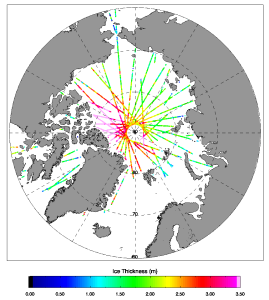Having just celebrated its milestone fifth birthday, CryoSat has become the first mission to provide information on Arctic sea ice thickness in real-time as an aid to maritime activities.
The European Space Agency’s (ESA) CryoSat satellite has been measuring the thickness of polar ice to the nearest centimetre since its launch in 2010. It is already the first mission to deliver complete maps of Arctic sea ice thickness – a key indicator of global climate change and of the state of the Arctic itself. Now, thanks to specialist data processing at CPOM, CryoSat is producing the first rapid measurements of Arctic sea ice thickness.
With measurements becoming available via a new website within two days of the satellite passing over the ice, the results will help people using the Arctic to plan and manage their activities, in addition to improving scientific understanding of the Polar Regions.
CPOM researcher Rachel Tilling explains: “We’ve already found that, although Arctic sea ice set a record this year for its lowest ever winter extent, it was about 25 cm thicker, on average, than in 2013, when CryoSat recorded its lowest winter volume.”
Although there is more ice overall than there was in 2013, in some places the sea ice has thinned progressively; for example north of Svalbard the winter sea ice is now only 1 metre thick – half what it was in 2011 when CryoSat made its first measurements of the area.
The latest measurements also show that sea ice around Svalbard, 1,300 miles from the North Pole, is today only a metre thick – approximately half what it was in the winter of 2011 just after CryoSat was launched. Professor Andy Shepherd, CPOM Director and principal scientific advisor to the CryoSat mission, added: “the thinner ice around Svalbard coincides with a warming of the surrounding Barents Sea.
“We’ve already seen the impact of this change in ocean conditions on Svalbard’s Austfonna ice cap, where glaciers have speeded up at unprecedented rates, and the rapid retreat of sea ice in this sector of the Arctic is almost certainly down to the same thing.”
As well as helping scientists to understand the rapidly changing Arctic environment, the real time CryoSat data will be a vital resource for maritime activities affected by sea ice, such as shipping, tourism, Arctic exploration, and of course search and rescue.
With economic growth in the Arctic estimated to be worth $100bn over the next two decades, timely and routine information on sea ice thickness will help to ensure that users of the Arctic can plan and carry out their operations safely and with care.
Professor Shepherd highlighted: “This new capability goes far beyond CryoSat’s original purpose, which was to collect measurements for scientific research; the mission is now an essential tool for a wide range of services operating in areas of the planet where sea ice forms.”
CryoSat’s real-time measurements were first trialled in Spring 2014 to guide a scientific experiment north of Greenland led by CPOM, and the service will be tested next week when the Norwegian Polar Institute’s Young Sea Ice mission carries out experiments in the sea ice pack north of Svalbard.
Speaking about CryoSat’s achievements, ESA mission manager Tommaso Parrinello said: “After five years of exploitation, CryoSat has provided important answers, but has also enlarged our lack of knowledge on several fundamental scientific questions.
“Similarly, CryoSat has shown the importance of its measurements for current and future operational and forecasting services on all Arctic latitudes, paving the way to the development of similar missions in future.”

